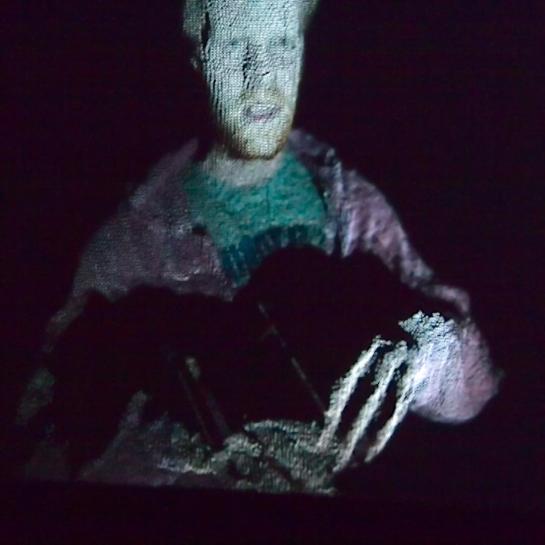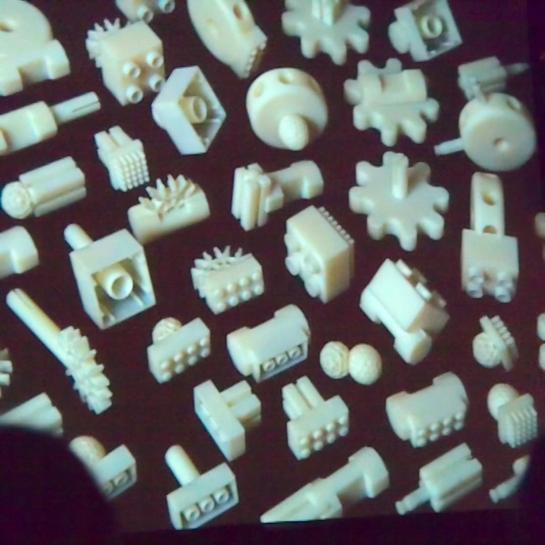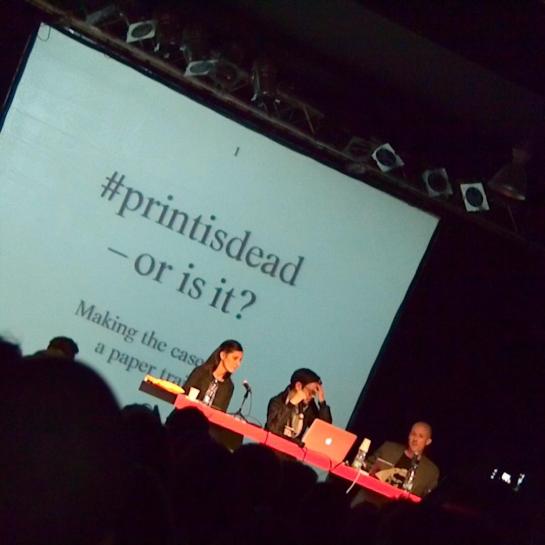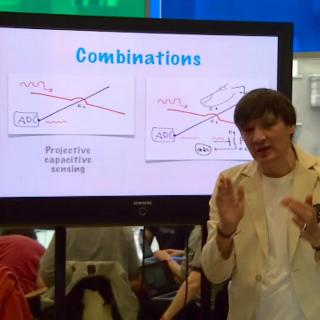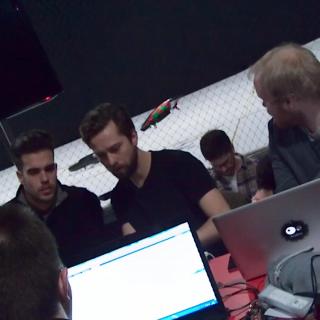A number of students interested in projection mapping converged for a demonstration at Raffles this Wednesday evening past. The demo was offered by Altamash Sayed of JVMedia, a young company which specializes in the development of applications and programming for interactive products and events all-over India. The demo was led by Samiran Mane, a.k.a. Alienvision, a freelancing visual artist who works for JVMedia when he is not travelling his art around to festivals world-wide. As a follow-up. you may want to check out some of the documentation links added from the Resonate Festival, which are started to be posted bit-by-bit: http://www.creativeapplications.net/tutorials/audio-reactive-mapping-with-touchdesigner-resonate-2013/
Tag Archives: animation
Resonate Day 3
The last day of the festival was the longest excluding the after-after party. It started with data, the kind you can eat, then the day moved through a run of presentations dealing with everything from Coding Narratives to interactive performance to Zimoun’s installation art.
I also managed to record a few interviews. The videos can be seen at: http://www.latuscreativity.it/
Given the array of talents at Memo Atken‘s disposal, it is possible to imagine any number influences which may have impacted him throughout his life, that is why it is perfectly logical that a cartoon like Tom & Jerry embodies, in one sense, the reason why he became a visual artist. No, it is not so much for the visuals or the qualities of the characterizations, but something more nostalgic and reminiscent of film before the talkies; That is, sound as a textured and driving force for a visual language. Though he did not have enough time show the selection of works he had intended, it was clear enough to see that he was more fond of the visual work which had a tight correlation to sonic events.
Casey Reas‘ presentation in the afternoon was like a rapid retrospective of his work in a lecture he labeled, the studio as software. He began the lecture by showing the paintings made by one of his friends. He mentions the ways in which they are similar, but, he says, the difference is that “… I have never used a brush.” It seems prudent to remind us that we are looking at a painter whose canvas includes the dimension of time and whose material is code. He is a programmer, certainly. But, one may judge, with over a decade of teaching designers how to program, and the way in which he has devised the Processing curriculum, that programming is not [at all] an end, but a universal means. I like his work for several reasons, one is that it somehow reminds of Al Held‘s paintings, but mostly because it is organic; a perfect example of how we strive to fashion the digital into analog, or perhaps just something more familiar in look and behavior. We can measure technological progress in any number of ways, but its ultimate success is determined by whether or not we are convinced enough, to integrate it further into our existence.

Moritz Stefaner explains how the preparation of food was determined by data.
Resonate Day 2
“Every kid starts out as a natural-born scientist, and then we beat it out of them. A few trickle through the system with their wonder and enthusiasm for science intact.” —Carl Sagan
The second day of Resonate was comprised of lectures spanning a range of fields and topics. The few lectures I was able to follow included a small panel of discussions which included a screening of trailer for a documentary called “Cloud” which is scheduled to be released as an interactive movie around July. The film features notable figures who are programmers in the fields of art and design. The movie itself is shot with a combination of hardware which includes Kinect attached to a DSLR. Appropriate, considering that those being featured are work so closely with the development and manipulation of technology. Amongst other things, this technique allows for the re-positioning of the camera perspective. You can read more about it on WIRED: http://www.wired.com/underwire/2012/06/clouds-code-kinect/
The day’s lectures ended with a presentation by Golan Levin. As a teacher and multimedia artist, he has developed techniques and collaborations spanning a couple of decades and many international borders, aside from initiating a solution for the inter-operability of various children’s toys, his experience in media art and breathe of knowledge regarding media art was clearly evident in his presentation as he revisited his past work through the eyes of his 6 year-old self. of He referenced a quote from Carl Sagan to further illustrate what he passionate referred as kind-of reconciliation for the experience of the unfamiliar that we come across more often as a child.
That is, as artists, we strive to experience and communicate a sense of something wondrous through the things we create. This, in turn, spawns more wonder and creativity.
Resonate Day 1
The Snow is falling, which, I guess, is better than the rain yesterday. But, that did not matter to the people participating in any one of the numerous workshops taking place at the Resonate Festival.
Not following any one in particular, I floated about checking out the process of various projects. Of course, the topics ranged greatly, but also the workshop techniques. Participants involved with stop-motion animation were busy building their animations, while other workshops consisted more of lectures and demonstrations. One which was fascinating was OpenCV. That is, Computer Vision, or the technique of how a pixels are processed and analyzed by a computer. This is a key mechanism for video-based interactions. The second workshop of interest was about Raspberry Pi, an exciting platform for controlling, sensing, and performing video processing with a $35 computer that fits in the palm of your hand. Not for the program fearing, as it takes a basic understanding of Linux-Debian to navigate and instruct the CPU. The bright side is that the community, and subsequent documentation, are all available online.
The after party was accompanied by the sounds of Pantha du Prince and 12 different bars in the city.

Memo Akten explaining his quadcopter storyboard for a Saatchi and Saatchi event from this past year.
Dreamworks Animations – What it takes to be there
How often have you asked yourself about the best hardware configuration for rendering 3D Animations. Well.. I found some interesting articles about Dreamworks Animations Studios where they share some statistics along with some insights to their processes and work flows.
Continue reading
Zynga’s Farmville 2 done in 3ds Max
Came across this article the other day. Never thought farmville will take a 3D avatar.
Zynga recently invited Autodesk to visit their San Francisco HQ to interview the development team behind FarmVille 2, the sequel to the popular casual 2D game FarmVille. The creative team discussed the studio’s new 3D pipeline, which it credits for the new look of the game. Take a look behind-the-scenes at how the Zynga team easily modelled, animated and rigged 3D characters and environments to build an engrossing and beautiful universe for gamers.

all characters animated in 3Ds Max
The Dutch Connection
Students studying Animation Principles just wrapped up a two-day, workshop for character design and rigging using Toon Boom animation software. The process of making the rigging is a tedious one, but by the end of the workshop, students felt like they had a powerful tool for animation.
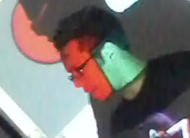 The workshop leader, artist and designer Sahal Merchant, is a native of Mumbai who currently lives in the Netherlands. Since living in Holland, his illustrative talents have been applied to animation and interactive products. Most recent work includes an animation series in collaboration with mediaheads.nl and an independent production of a book series called Bruno the brown bear/Gaudi l’orsetto bruno an interactive book for Italian and English speaking children 3-7 years.
The workshop leader, artist and designer Sahal Merchant, is a native of Mumbai who currently lives in the Netherlands. Since living in Holland, his illustrative talents have been applied to animation and interactive products. Most recent work includes an animation series in collaboration with mediaheads.nl and an independent production of a book series called Bruno the brown bear/Gaudi l’orsetto bruno an interactive book for Italian and English speaking children 3-7 years.




